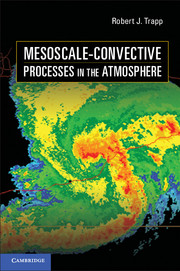Book contents
- Frontmatter
- Contents
- Preface
- 1 The Atmospheric Mesoscale
- 2 Theoretical Foundations
- 3 Observations and Mesoscale Data Analysis
- 4 Mesoscale Numerical Modeling
- 5 The Initiation of Deep Convective Clouds
- 6 Elemental Convective Processes
- 7 Supercells
- 8 Mesoscale Convective Systems
- 9 Interactions and Feedbacks
- 10 Mesoscale Predictability and Prediction
- References
- Index
- Plate section
7 - Supercells
A Special Class of Long-Lived Rotating Convective Storms
Published online by Cambridge University Press: 05 March 2013
- Frontmatter
- Contents
- Preface
- 1 The Atmospheric Mesoscale
- 2 Theoretical Foundations
- 3 Observations and Mesoscale Data Analysis
- 4 Mesoscale Numerical Modeling
- 5 The Initiation of Deep Convective Clouds
- 6 Elemental Convective Processes
- 7 Supercells
- 8 Mesoscale Convective Systems
- 9 Interactions and Feedbacks
- 10 Mesoscale Predictability and Prediction
- References
- Index
- Plate section
Summary
Synopsis: This chapter is devoted to an in-depth discussion of the class of thunderstorms known as supercells. A hallmark of a supercell is a long-lived rotating updraft. Such mesocyclonic rotation influences the supercell dynamics, and in turn the supercell intensity, longevity, motion, and structure. Rotation generated near the ground and then become concentrated to form a tornado. A description of the sequence of processes leading to tornadogenesis is included in this chapter, as is a summary of parameters that help quantify the supercell environment. Some concluding remarks are made regarding tropical convective phenomena that share some of the same characteristics as supercells.
Characteristics of Supercell Thunderstorms: An Overview
Observations with weather radar from the 1950s through the 1970s revealed the existence of single large thunderstorms that persisted for periods of several hours, a time much longer than thought typical. These intense storms also were observed to have an atypical movement – in directions to the right and/or left of, rather than parallel to, the cloud-bearing environmental winds. Finally, the storms were distinguished on radar by a persistent, internal circulation that coupled a primary updraft with downdrafts and rotation about a vertical axis.
- Type
- Chapter
- Information
- Mesoscale-Convective Processes in the Atmosphere , pp. 195 - 232Publisher: Cambridge University PressPrint publication year: 2013



